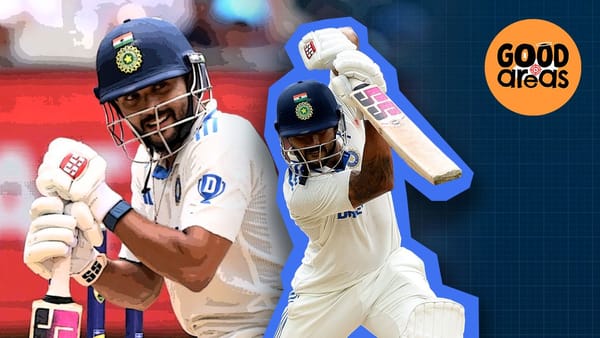Leg spin has taken over women's cricket
From nothing to everything, women are now bowling high quality and high quantity leg spin all over the place.
When I started watching women's cricket, one thing was missing, leg spin. If you saw someone bowling, it would be a part-timer tossing the ball up and hoping it would land. There was lots of dirty off spin out there. But cricket's dark art was missing.
It is not that women’s cricket has never had leg spin. Peggy Antonio took 137 wickets in 24 first-class matches at an average of 9.37. But by the early 2000s women’s bowling was basically fairly vanilla finger spin or swing bowling.
If you have followed the World Cup so far you will have noticed that is no longer the case. Australia has so many leg spinners they left Amanda Jade Wellington at home.

And she has the most wickets in major women's T20s over the last three years. Not by a leg spinner, like this is of all bowlers. But Australia has a collection to choose from, and she missed out.
Since women's franchise cricket is new, it's hard to look at the numbers. So thanks to Hypocaust, we've put together the numbers from major women's internationals. This is the percentage of legspin each year. You can see that when I started watching, there was none. A couple of years later, we have a bump up to 5% over a few years. And then suddenly, it's everywhere.

Here is the major men's T20I data from the same period to show how dramatic it was. You can see leg spin is there from the start, but it grows slowly and never gets to the level the women do. At the international level, we find female leggies easier than men.

And just lastly, I wanted to add franchise men's cricket to this. Because that is a place where leg spin has been used the most, as it can be purchased rather than homegrown. Being able to buy it in means we see a lot more of it early on before it plateaus under the women's T20I but on top of the men's. I didn't expect this, but somehow after the slowest start, women's cricket is where you see the most leg spin.

So, I wanted to take a look at the top bowlers.
Sarah Glenn
England's Sarah Glenn has a stupid record at the top level so far, averaging 16 and going at less than a run a ball. You can see her bio-mechanics look all over the place. There is no solid front arm, and she bowls with a very low arm for a leg spinner.
But, while this doesn't look repeatable, her numbers so far suggest otherwise. And it also gives her another advantage. She always keeps the stumps in play. It is a style similar to Hasaranga, and I feel she's bowling someone or getting LBWs every time I see her play. That makes her very hard to get under and smash.
It's a funky technique, but it does make sense from a T20 perspective. She should be hard to hit, and if you miss she is probably getting a wicket.
Alana King
I do not have any numbers that back this up, but I would guess Alana King gets a lot more turn than the others. She has a more pure side spin action, and it's not just that she gets the ball to rip, but there is plenty of drift in her deliveries as well.
There is something a bit old-fashioned about her, the ball goes up out of her hand and then spins a long way. Most of her wickets are traditional leggie style, dragging people down the wicket, ripping past the outside edge, and swipes that end up in the gully.
But another thing I really like, and I haven't seen much, is how often she comes around the wicket. There aren't many leg spinners pitching outside leg stump, but she is also good at it. We've seen her bowl people around the legs in white ball cricket. It is a lovely quirk.
Afy Fletcher
West Indies' Afy Fletcher is pretty similar to King. She has a bit of a sling-arm action, but it comes out like a traditional leg spinner. She managed to bamboozle Nat Sciver-Brunt by the drift, much like Warne’s magic delivery to Mike Gatting. Most of Fletcher's wickets seem to be from sweeps. Her drift helps in this.
Also, she is a great celebrator, and that counts for a lot.
Poonam Yadav
When Poonam Yadav gives the ball air, it goes into deep space orbit before coming back down. This kind of trajectory makes young leg spinners so hard to play at times. The ball doesn't just go above eye level, it is a whole new kind of air.
I first thought that people should be coming around the wicket and smashing it very far. But that doesn't happen as often because of her second skill of bowling probably the most undetectable - and just flat-out best - wrong'un in women's cricket. If you do race at her, you have to be pretty sure which way the ball is going.
Also, the sweep is quite an essential part of women's cricket, and it is tough to sweep someone bowling this slow and flighting the ball this high. So she is restricting the amount of attacking shots people can safely play off her.
Amelia Kerr
Amelia Kerr is probably the closest to what we see in men's as a modern style of T20 leggie. She has more pace on her deliveries, is more direct, and works on hitting a good length repeatedly instead of other more old fashion kinds of leg spin.
If anyone on this list should be a powerplay leggie, it would be her. As she gets more balls to slide on and bowls knee roll length balls batters would struggle to hit across the line with a new ball.
The ball doesn't go much above the eyes, and it also doesn't get as much spin. But her ability to beat you with the straight one - her wrong'un is hard to pick, but actually goes more straight than big turn the other way - keeps players guessing. And she is hard to get down to because she is quicker than the others.
Georgia Wareham
She is very similar to Kerr. Wareham is the best thing to come out of Terang since Chris Heffernan, and she again bowls this straight, slightly quicker leg spin. She might be the most technically proficient of anyone here.
And she is also very clever and able to adjust on the fly. She observes the batter carefully to see if they are stepping out, so she can bowl a wide one and get them stumped.

She also has a T20 bowling average of 13. Of all the players whose teams have qualified for this World Cup, you will not be surprised to know that this is the best average.
This is a good group of bowlers. But I think the interesting thing for me is the amount of leg spin, but then also the variation of it. Considering how late it started, this is an apparent four styles of leg spin that have developed independently.
And again you will not be surprised that three of the top eleven wicket-takers at this World Cup are leggies. With bowling averages of 10, 9 and 12, respectively.

To go from nothing to so much of this quality and variety is such a dramatic change. And it's a good thing because there is nothing in life that cannot be improved by leg spin.




